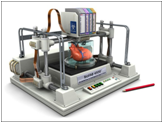题目内容
13.Most schools in America do not have the latest equipment in laboratories.It is just too costly.But the eastern state of Maryland and8 non-profit group found a way to make such equipment available during the school year.They put it on a bus!The 13-meter-long Maryland BioLab is a mobile classroom filled with equipment that lets students explore many kinds of science.It travels around the state visiting schools.It has everything from biology to forensic science(法医学).The mobile lab has been bringing bioscience education to schools around Maryland for more than 10 years,
"It is really nice to get the students in here with hands-on activities.They get really excited and want to be engaged."said Ms.Mangus,who is in charge of the program.She said that many students finished their experiments and left the bus excited about the possibility of becoming a scientist.
At the end of each class,Ms.Mangus talked to the students about how she became a scientist."If we have enough time,we like to take five,ten minutes and talk about us,ourselves.I tell them how I got into science,maybe where I went to school,what I did,and the different kinds of things we could do."
Brian Gaines,the chief executive officer of the foundation supporting the BioLab program,said the organization's goal was to help create the next generation of scientists."We use this program to talk about careers in science-not only science,but science,technology,engineering and math.Students on the bus get real-life experience they do not get in a classroom."
56.Which of the following is true about the BioLab?B
A.It visits schools around the United State.
B.It's a mobile lab for the schools in Maryland.
C.It is used to replace the ordinary classroom.
D.It is equipped with all kinds of school things.
57.The students are very pleased becauseA.
A.they can do experiments with their own hands
B. they can have face-to-face talks with scientists
C.the bus comes to their school every day
D.they can realize the dreams of being scientists
58.Ms.Mangus talked about her experience toC.
A.make her classes lively and interesting
B.show off her achievements
C.arouse the students'interest in science
D.get the students more involved in class
59.According to Brian Games,the real purpose of the program is toA
A.help create the future scientists
B.prepare students for future careers
C.improve students'marks in schools
D.save money for the government
60.Which of the following would be the best tide for the test?D
A.Bioscience Education in America.
B.A New Way to Do Experiments!
C. The Way to Be a Scientist.
D.A BioLab on a Bus!
分析 本文介绍的是马里兰州BioLab给当地高中用卡车带来可移动科学设备,供学生亲手做实验,以培养和激发学生的科学兴趣.
解答 BACAD
56.答案 B 细节理解题 根据But the eastern state of Maryland and8 non-profit group found a way to make such equipment available during the school year.They put it on a bus!可知,这是在美国的 Maryland州的东部学校使用,而不是整个美国,不可能取代传统实验室,不是配备所有的实验设备,故答案为B
57.答案 A 细节理解题 根据"It is really nice to get the students in here with hands-on activities.They get really excited and want to be engaged.可知,孩子们高兴是因为可以亲手做实验,故答案为A
58.答案 C 推理判断题 根据Ms.Mangus所说"If we have enough time,we like to take five,ten minutes and talk about us,ourselves.I tell them how I got into science,maybe where I went to school,what I did,and the different kinds of things we could do"可以推断出这可以激发学生们对科学的兴趣,故答案为C
59.答案 A 细节理解题 根据最后一段Brian Gaines,the chief executive officer of the foundation supporting the BioLab program,said the organization's goal was to help create the next generation of scientists."可知,组织的目的是为了培养下一代科学家,故答案为A
60.答案 D 主旨大意题 通读全文可知,这是介绍的是马里兰州BioLab给当地高中用卡车带来可移动科学设备,供学生亲手做实验,以培养和激发学生的科学兴趣,故最佳标题应该是A BioLab on a Bus!,更简洁,更醒目.故答案为D
点评 1、要想做好科普英语阅读理解题,同学们就要注意平时多读科普知识类文章,学习科普知识,积累常见的科普词汇,从根本上提高科普英语的阅读能力.
2、要熟悉科普类文章的结构特点.科普类文章一般由标题(Head line),导语(Introduction),背景(Back ground),主体(Main body)和结尾(End)五部分构成.标题是文章中心思想高度而又精辟的概括,但根据历年的高考情况来看,这类阅读理解材料一般不给标题,而要同学们选择标题.导语一般位于整篇文章的首段.背景交待一个事实的起因.主体则对导语概括的事实进行详细叙述,这一部分命题往往最多,因此,阅读时,同学们要把这部分作为重点.结尾往往也是中心思想的概括,并与导语相呼应,命题者常在此要设计一道推理判断题.
3、在进行推理判断时,同学们一定要以阅读材料所提供的科学事实为依据,同时所得出的结论还应符合基本的科普常识.

| A. | in common | B. | in particular | C. | in practice | D. | in need |

| A.rejected B.eventually C.various D.ready E.commercialize F.prospect G.delivered H.employed I.samples J.transplants K.inevitably |
The invention of 3D printing provided a technology now (44)H to manufacture everything from aircraft parts to body parts.But the (45)F of 3D bioprinting is even brighter; to create human tissues for research,drug development and testing,and (46)B as replacement organs,such as a kidney,for patients desperately in need of (47)J.Bioprinted organs could be made from patients'own cells and thus would not be (48)A by their immune systems.They could also be manufactured on demand.
At present only a few of companies are trying to (49)E the production of bioprinted tissues.But Thomas Boland,an early pioneer in the field,says that plenty of others are interested.He also estimates that about 80teams at research institutions around the world are now trying to print (50)C small pieces of tissues such as skin,blood vessels,liver,lung and heart."It's a wonderful technology to build three-dimensional biological structures."says Gabor Forgaces,who co-founded Organovo in 2007.